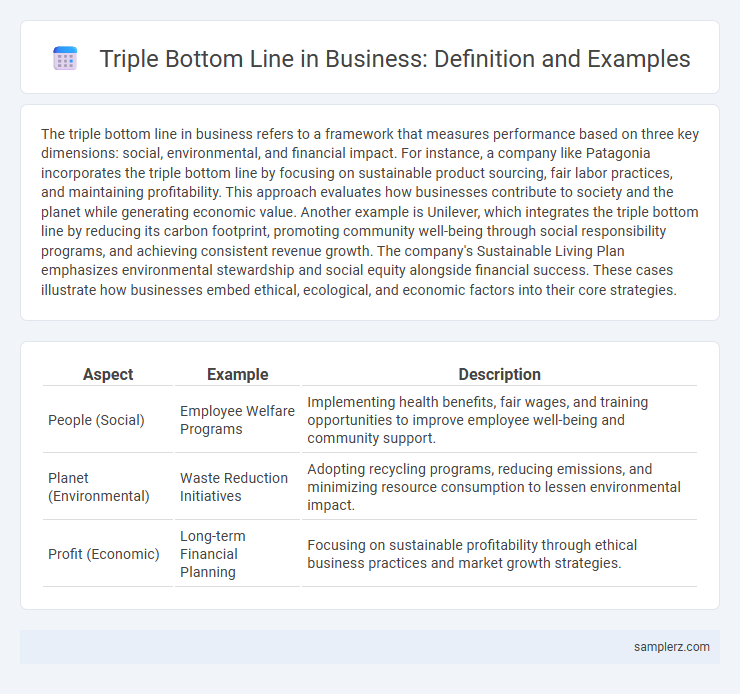The triple bottom line in business refers to a framework that measures performance based on three key dimensions: social, environmental, and financial impact. For instance, a company like Patagonia incorporates the triple bottom line by focusing on sustainable product sourcing, fair labor practices, and maintaining profitability. This approach evaluates how businesses contribute to society and the planet while generating economic value. Another example is Unilever, which integrates the triple bottom line by reducing its carbon footprint, promoting community well-being through social responsibility programs, and achieving consistent revenue growth. The company's Sustainable Living Plan emphasizes environmental stewardship and social equity alongside financial success. These cases illustrate how businesses embed ethical, ecological, and economic factors into their core strategies.
Table of Comparison
| Aspect | Example | Description |
|---|---|---|
| People (Social) | Employee Welfare Programs | Implementing health benefits, fair wages, and training opportunities to improve employee well-being and community support. |
| Planet (Environmental) | Waste Reduction Initiatives | Adopting recycling programs, reducing emissions, and minimizing resource consumption to lessen environmental impact. |
| Profit (Economic) | Long-term Financial Planning | Focusing on sustainable profitability through ethical business practices and market growth strategies. |
Introduction to Triple Bottom Line in Business
The triple bottom line in business emphasizes three core components: social responsibility, environmental sustainability, and economic profitability. Companies like Patagonia integrate ethical labor practices and environmental stewardship while maintaining strong financial performance, exemplifying this approach. This framework drives businesses to measure success beyond profits, fostering long-term value for stakeholders and the planet.
Environmental Responsibility: Real-World Corporate Examples
Patagonia exemplifies environmental responsibility by integrating sustainable materials and rigorous supply chain audits, significantly reducing its carbon footprint. Unilever's Sustainable Living Plan commits to sourcing 100% of agricultural raw materials sustainably, enhancing biodiversity and reducing greenhouse gas emissions. IKEA invests heavily in renewable energy, aiming to become climate positive by 2030, demonstrating leadership in circular economy practices and waste reduction.
Social Impact Initiatives in Leading Companies
Leading companies such as Patagonia and Unilever exemplify the triple bottom line by integrating social impact initiatives that prioritize community welfare and employee well-being alongside profitability. Patagonia's commitment to fair labor practices and environmental activism directly supports its social responsibility goals, enhancing brand loyalty and stakeholder trust. Unilever's Sustainable Living Plan drives social value through projects that improve health and education in underserved markets, demonstrating how businesses can achieve sustained social and economic benefits.
Economic Sustainability: Profitable and Responsible Businesses
Economic sustainability in business emphasizes generating consistent profits while maintaining responsible practices that benefit society and the environment. Companies like Patagonia illustrate this by integrating ethical sourcing and transparent operations with strong financial performance. This approach ensures long-term viability by balancing economic growth with social and environmental accountability.
Global Brands Championing Triple Bottom Line
Global brands like Patagonia, Unilever, and Tesla exemplify the triple bottom line by integrating environmental sustainability, social responsibility, and economic performance into their core strategies. Patagonia's commitment to eco-friendly materials and fair labor practices aligns with its profit goals, while Unilever's Sustainable Living Plan accelerates growth by reducing environmental footprints and enhancing community well-being. Tesla advances sustainable innovation by producing electric vehicles that cut carbon emissions, proving that profitability can coexist with positive social and environmental impact.
Small Businesses Implementing Triple Bottom Line Strategies
Small businesses implementing triple bottom line (TBL) strategies often prioritize social impact by supporting local communities and fair labor practices while reducing environmental footprints through sustainable sourcing and energy efficiency. Financial performance is maintained by optimizing operations and exploring green product lines that attract eco-conscious customers. Examples include locally-owned coffee shops using organic beans, paying fair wages, and investing in renewable energy to balance profit, planet, and people goals.
Industry-Specific Triple Bottom Line Practices
In the manufacturing industry, companies implement the triple bottom line by reducing carbon emissions through energy-efficient machinery while ensuring fair labor practices and community development programs. In the retail sector, businesses focus on sustainable sourcing of products, maintaining employee welfare, and investing in local social initiatives to drive economic growth. Agriculture firms adopt water conservation techniques, promote equitable treatment of farmworkers, and support rural education, demonstrating a commitment to environmental, social, and economic sustainability.
Measuring Triple Bottom Line Success: Case Studies
Measuring triple bottom line success involves evaluating financial profitability, social impact, and environmental sustainability through case studies like Patagonia, which integrates eco-friendly materials and fair labor practices while maintaining strong revenue growth. Unilever's Sustainable Living Plan demonstrates measurable improvements in health and well-being, reduced environmental footprint, and consistent shareholder returns. These companies use data-driven frameworks combining metrics such as carbon emissions reduction, community development indices, and economic performance to track progress comprehensively.
Innovations Driving Triple Bottom Line Outcomes
Innovations in sustainable technologies, such as renewable energy solutions and circular economy practices, enhance the triple bottom line by simultaneously improving environmental impact, social equity, and economic performance. Corporations investing in eco-friendly product design and community engagement programs achieve measurable reductions in carbon footprint while fostering positive stakeholder relationships and boosting profit margins. Data from companies adopting these innovations reveal increased operational efficiency, elevated brand reputation, and stronger long-term financial resilience.
Future Trends in Triple Bottom Line Business Models
Future trends in triple bottom line business models emphasize integrating advanced sustainability metrics, leveraging technology for real-time environmental impact tracking, and fostering stronger community engagement to enhance social value. Companies increasingly adopt circular economy principles, reducing waste while improving resource efficiency and long-term profitability. Enhanced regulatory frameworks and stakeholder demand drive innovation in balancing profit, people, and planet for resilient business growth.

example of triple bottom line in business Infographic
 samplerz.com
samplerz.com